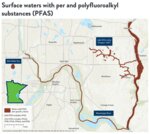South Washington County is no stranger to PFAs contamination. On May 4, the EPA held a public hearing that revealed it’s not alone.
Taking place over an eight-hour period via Zoom, a …
This item is available in full to subscribers.
To continue reading, you will need to either log in, using the login form, below, or purchase a new subscription.
If you are a current print subscriber, you can set up a free website account and connect your subscription to it by clicking here.
Otherwise, click here to view your options for subscribing.
Please log in to continue |


















South Washington County is no stranger to PFAs contamination. On May 4, the EPA held a public hearing that revealed it’s not alone.
Taking place over an eight-hour period via Zoom, a nationwide public hearing on the new proposed EPA rule related to six different PFAs was orderly. The six PFAs under agency review in relation to the new rule are perfluorooctanoic acid (PFOA), perfluorooctane sulfonic acid (PFOS), perfluorononanoic acid (PFNA), perfluorohexane sulfonic acid (PFHxS), perfluorobutane sulfonic acid (PFBS), and hexafluoropropylene oxide dimer acid (HFPO-DA), the last commonly known as GenX Chemicals.
Valued by industry for their overall stable and non-reactive properties, these same chemicals have been linked to severe health impacts including those related to pregnancy and newborns, as well as the liver and various cancers. Common uses of these chemicals also include stain/waterproofing agents along with firefighter foams, the latter used to smother fires for which conventional methods are not effective.
As such, the new proposed rule from the EPA calls for a legally enforceable Maximum Contaminant Level (MCL) of 4.0 parts per trillion (ppt) on PFOA and PFOS, with each of the four others put on a Hazard Index.
The value of 4.0 ppt for PFOA and PFOS is based on the level that can be reliably detected in tests, while the non-legally enforceable Maximum Contaminant Level Goal (MCLG), is zero.
Those contaminants to receive a Hazard Index value (PFNA, PFHxS, PFBS, and HFPO-DA) will have this calculated by taking each of the four divided by a set value, and then adding these four fractions together for a Hazard Index (HI) value. If the combined fractions for a running annual average HI value is above 1.0 on a unitless scale, it will be deemed a violation of the Hazard Index MCL value.
Following official publication in the federal register by the end of 2023, municipalities will have three years to do initial water monitoring, being required to notify the levels of each PFAs if these exceed proposed standards and take steps to reduce levels in drinking water if these exceed the standards. These requirements take effect upon official publication of the proposed rule, with no action mandated as yet. Laboratories are available to process samples for the proposed levels, with municipalities that have existing data may use this to satisfy pre-monitoring requirements, provided this is done with detection methods 531 or 571, full details in Section IX of the proposed rule.
The proposed EPA rule with regards to PFOA and PFOS are based on statistically significant (i.e., “unlikely to happen by chance”) findings with regard to kidney, liver, and testicular cancer in rats (for PFOA) as well as liver and pancreatic cancers (for PFOS). With regard to PFOS specifically, both Carp and Sunfish in the Mississippi River between Ford Dam and Hastings have shown the presence of this chemical, per the state department of health. With regard to help for municipalities in meeting the new requirements, $9 billion will be made available in potential aid to help shoulder the costs of meeting government regulation, thanks to the Bipartisan Infrastructure Law Funding for PFAs. A total of $4 billion will come through the Safe Drinking Water State Revolving Fund (DWSRF) while another $5 billion will be made available through the EPA’s Emerging Contaminants in Small or Disadvantaged Communities Grant Program.
An additional $12 billion may be accessed through funds in the Bipartisan Infrastructure Law DWSRF, related to making drinking water safer.
Whereas municipalities have three years from rule publication to enact the new standards, the City of Cottage Grove is among those which have already started the path towards mitigating the effects of PFAs with help from a settlement with 3M, two interim water treatment plants, and a permanent treatment plant planned for later this decade. Methods of removing PFAs mentioned in the May 4 EPA hearing include activated carbon and high pressure membranes, the City of Cottage Grove using the former.
With written public comments being accepted through May 30 online and publication of the final rule planned for the end of 2023 in the federal register, those interested in making comment on the proposed rule can download the proposed rule and find more information at https://www.regulations.gov/document/EPA-HQ-OW-2022-0114-0027.